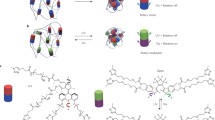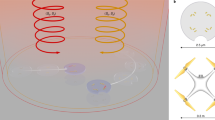Abstract.
Light can change the orientation of liquid-crystal molecules. Usually, the torque that causes the reorientation originates in angular-momentum transfer from the radiation field to the material. If a small amount of dichroic dye is dissolved in the liquid crystal, a light-induced torque can appear essentially without the transfer of angular momentum from light. We show that, in such cases, the dye molecules act as light-driven molecular motors which, via an orientational Brownian ratchet mechanism, transfer angular momentum, which originates at the cell walls, to the liquid crystal. Understanding the details of this mechanism is important for applications ranging from flat-panel displays to optomechanical transducers.
Similar content being viewed by others
Author information
Authors and Affiliations
Additional information
Received: 20 October 2001 / Accepted: 14 January 2002 / Published online: 22 April 2002
Rights and permissions
About this article
Cite this article
Palffy-Muhoray, P., Kosa, T. & E, W. Brownian motors in the photoalignment of liquid crystals . Appl Phys A 75, 293–300 (2002). https://doi.org/10.1007/s003390201321
Published:
Issue Date:
DOI: https://doi.org/10.1007/s003390201321




